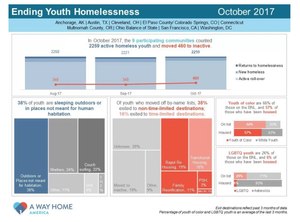
In 2017, HUD supported a series of 100-Day Challenges to house homeless youth in cities and counties nationwide, ending youth homelessness for hundreds at a time.
A study published in this month’s Journal of Adolescent Health has found that one in 10 of youth in the United States experience homelessness annually, but homeless youth is an issue U.S. Housing & Urban Development (HUD) Youth Homelessness Demonstration Program (YHDP) grants have been addressing through a series of 100-Day Challenges in 2017 that moved kids on the street into stable housing.
Each challenge in each city might result in getting anywhere from 50 to upwards of 300 homeless youth into housing, based on the benchmarks published by the U.S. Interagency Council on Homelessness (USICH) in January 2017.
The 100-Day Challenges bring together service providers as well as local and state governments, law enforcement agencies that seek to end youth homelessness by reassessing and streamlining housing operations and sharing resources. Funding from HUD helps address things like case management and mental health services in the rush of getting homeless youth into stable housing.
“The 100-Day Challenge is designed to stimulate intense collaboration, innovation and execution in pursuit of an ambitious 100-day goal,” according to USICH.
In its July 2017 report , USICH said that the Federal government is providing technical assistance to more than 50 communities that submitted applications to YHDP (more than 130) to develop coordinated community plans. For FY 2017, Congress allocated an additional $43 million to fund additional communities under YHDP.
HUD, in partnership with A Way Home America , Rapid Results Institute and HomeBase , are building off the success of the first cohort of 100-Day Challenges, which included Austin, Texas. In September 2016, non-profit community organizations like LifeWorks launched efforts to get 50 homeless youth off the streets, and they achieved it, according to KXAN .
Since that time, city of Austin (which received $5.2 million of the $33 million HUD FY 2016 YDHP grants) has continued to work on finding and adding the names of homeless youth to a by-name list, and then apply strategies like rapid rehousing, family reunification and permanent supportive housing to get them off the list and into non-time-limited destinations.
Baltimore, Maryland, Columbus, Ohio, Hennepin County, Minnesota, Louisville, Kentucky, and Palm Beach County, Florida, launched their 100-Day Challenges in August 2017, moving 671 homeless youth into stable housing.
The problem is, however, far from solved.
The October 100-Day Challenge involved nine cities, counties, a portion of the state of Ohio and the District of Columbia, and counted more than 2,259 homeless youth mostly sleeping outside, in a shelter or couch surfing.
City of Austin, part of the challenge, still had 237 on its by-name list moving a handful of homeless youth off the list each month.
But other cities are drawn to collaborating to end youth homelessness based on the achievements of 100-Day Challenges, like Abilene, Texas, which launches its challenge on January 25th, according to BigCountryHomepage.com.
In November 2017, HUD and its partners selected the rural communities of Franklin County, Maine, the Gulfport, Mississippi, Marion County, Oregon, Sioux Falls, South Dakota, and Mendocino County, California, for the next challenge round as part of its Rural YHDP program, according to the announcement .
Daley Barnwell-Moore, of the National Youth Forum on Homelessness, said that “The 100-Day Challenge has propelled communities forward into a unique world of creative problem solving. It encourages youth and young adult engagement and intentional collaboration. [Communities] are navigating those untreaded roads and they are leading to ‘Rapid Results.’”
One of the HUD YHDP grant requirements is youth voice must be at the table. Cities and local governments selected for YHDP funds must coordinate with youth advisory boards.
According to The Daily Bull Dog , New Beginning of Lewiston, Maine, the United Way of the Tri-Valley Area, Safe Voices, Healthy Community Coalition and Western Maine Homeless Outreach and others are working to launch the challenge in Franklin County with highly localized support:
A lot of homeless kids in rural areas of Maine end up in the shelters in Bangor, Augusta or Portland. They couch surf until they’ve burned all their bridges then head to the urban areas. But when they do that they lose their network, their connections and their supports. We want to figure out how to better serve them in their own communities, so that they don’t lose all that. If we can create something that works here we can probably replicate it in other rural areas across the state,” said New Beginnings’ Executive Director Chris Bicknell.
Copyright © 2025 GovGrantsHelp.com. All rights reserved.
